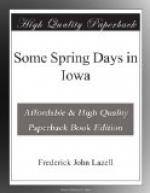"The
faint auroral flushes sent
Along the wavering vista of
his dream."
The edge of the cliff is lined with shad-trees. Each twig is a plume of feathery dainty white The drooping racemes of white blossoms, with the ruby and early-falling bracts among them look like gala decorations to fringe the way of Flora as she travels up the valley. The shad-trees have blossomed rather late. In them and under them it is fully spring. There is a sound of bees and a sense of sweetness which make us forget all the cold days and think only of the glory of the coming summer. There comes a song sparrow and perches on one of the twigs. He throws back his little head, opens his mouth and pours forth a flood of melody. Next comes a myrtle warbler, eager to show us the yellow on his crown, on his two sides and the lower part of his back. He is one of the most abundant of the warblers and one of the most charming and fearless. He perches on a hop hornbeam tree from which the catkins have just shed their yellow pollen and goes over it somewhat after the manner of a chickadee or a nuthatch, showing us as he does so the white under his chin, the two heavy black marks below that, the two white cross bars on his wings, and his coat of slate color, striped and streaked with black. He goes over every twig of the little tree and then flies off to another, first pausing, however, to give his little call note “tschip, tschip” and then his little song, “Tschip-tweeter-tweeter.” A pair of kingfishers, showing their blue wings and splendid crests, fly screaming down the creek. Their nest is in a tunnel four feet in the clay banks on the opposite side.




